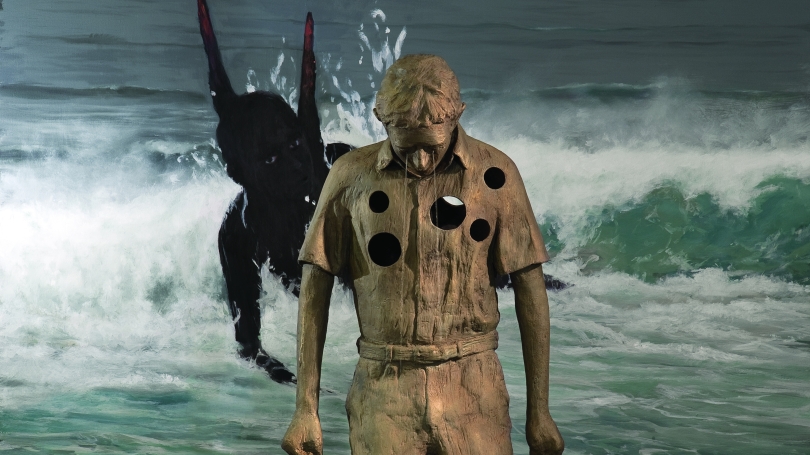Enrique Martínez Celaya: Burning as It Were a Lamp
Hood Quarterly, summer 2014
Juliette Bianco, Deputy Director
We are delighted to introduce Miami-based artist Enrique Martínez Celaya to the Dartmouth and local communities with the exhibition of his most recent work, Burning as It Were a Lamp (2013), on view for just five weeks this summer. Martínez Celaya will be in residence for the month of July as a Montgomery Fellow. In addition to two public engagements, he will spend his time on campus meeting and talking with faculty and students, and beginning work on a major site-specific commission for the Hood Museum of Art.
Burning as it Were a Lamp is an experiential environment consisting of a few simple elements—two paintings, a bronze boy who cries into the basin in which he stands, and several mirrors. The nature of the work unfolds as the viewer enters the gallery space and is only fully revealed when he or she is surrounded by the installation's mirrored walls. Martínez Celaya cites as inspiration for his nearly life-long fascination with the mirror a passage from Friedrich Nietzche's philosophical novel Also Spoke Zarathustra (1883–85), which he read while in middle school:
Why did I startle in my dream, so that I awoke? Did not a child come to me, carrying a mirror?
"O Zarathustra"—said the child unto me—"look at thyself in the mirror!"
But when I looked into the mirror, I shrieked, and my heart throbbed: for not myself did I see therein, but a devil's grimace and derision.
The theme of the mirror, and the self-reflection it provokes, recurs throughout Martínez Celaya's work, and in this case is embodied not only in the physical mirror but also in the pool of tears at the boy's feet. The artist writes of his created world in Burning as It Were a Lamp that its use of "repeated, intertwined, anachronistic images announces our uncertainty as well as our fragile and limited apprehension of ourselves and the world in which we believe ourselves to be. The reflected burnt angel [in one painting] and crying bronze boy are phantom consciences whose existence echo[es] ours, and so as we interact with this reflected world our own dissolves."
Enrique Martínez Celaya draws strongly from his life story—he moved from Cuba to Spain, to Puerto Rico, and finally to the United States—in his work, which often involves the individual's relationship to place. Martínez Celaya, who works as a painter, installation artist, filmmaker, and writer, did not begin his young adult life in the arts, but in the sciences. He majored in applied physics at Cornell University and pursued a Ph.D. in quantum electronics at the University of California, Berkeley, with a fellowship from the Brookhaven National Laboratory. Just before completing his degree, he turned back to something that he had started while living in Puerto Rico—painting—and he has been creating ever since.
Join us on July 15 for Enrique Martínez Celaya's Montgomery Endowment Lecture, and on July 22 when the artist will present a gallery talk in the exhibition. Details for both events are located in the Calendar of Events.
